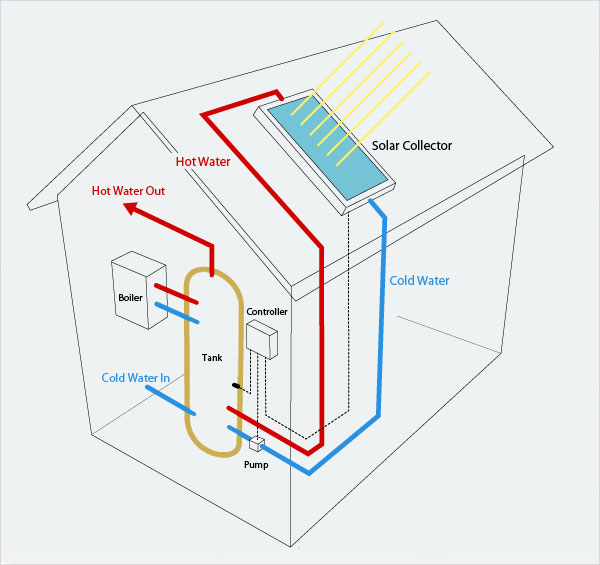
- info@uenergysolar.com
- +92 42 35312001

U Energy are installers of Solar Thermal technology, which uses the light from the sun for the hot water in your household, which can be used for baths, showers, dishwashers and any other appliances that go through the storage tank. This however is not in general used for radiators or general heating.
Usually, these systems consist of a solar collector, a boiler, a storage tank a pump and a controller. These are closed loop systems, in which the water that is used for washing etc. doesn't touch the fluid in the solar collector, ensuring it is hygienic. The fluid is silently sent through the system which is then heated by the Solar energy stored up in the solar collectors and then heating coils make the clean water hot. The controller that is installed with it ensures that this is done to maximum efficiency, as this responds to the temperatures of the fluid(s) in order to create maximum efficiency.
In a perfect world, a storage tanks would be twin-coiled; with the upper region being heated from the boiler and the lower coil being heated from the solar collector. In this way, as the hot water rises, the solar collector heats/provides as much as possible, before the boiler tops up the rest of what is needed. This means the solar energy provides as much as possible, even in the colder and darker months.
Unfortunately, the often used 'combination boilers' don't work well with this system, and while problems can be overcome with them, it's often better to completely replace the boiler. This depends on individual cases though, and our experts will go through all options with you when necessary.
Contrary to belief, the technology behind solar thermal collectors is vastly different to that of Solar PV designs. There is a meandering copper pipe work in collectors, and this layout maximises the time of the heating fluid within the collector, and ensures that everything is spread evenly around the system. This is covered by Sunselect absorber coating, which is purpose designed to soak up lots of sunlight and convert this into heat. Direct contact with this coating is the main proprietor of the transfer of heat into the copper piping.
Above this is a layer of low-iron content glass, which has the dual purpose of protecting the coating, and maximising the amount of light that can get through. It also helps keep heat in the generator in general and has what is almost a 'greenhouse' effect. A layer of fibreglass insulation makes sure heat can't easily get out of the panel.
All of this is held together by anodised aluminium, which serves as a lightweight and survives all weather conditions and corrosions, meaning it is perfect for roof mounting.
For the smallest system, which would be perfect for a house of two fairly water conscious people, would price at about £4,000 including installation and parts. A £400 grant is available though from the low carbon building program.
For every household, there is a maximum sensible size for a solar thermal system with regards to what the potential hot water usage of that property could be. A solar thermal system of the right size is expected to save you between 50-70% of your annual water bill, which constitutes roughly a third of your gas bill. Therefore, the solar thermal system could save you 15% of your gas expenses every year.
Properties with sufficient roof space are mostly eligible for solar thermal installations, and while a south facing roof would be perfect, other roofs can also be utilised with little problems for solar thermal energy. A site survey is best to deduce what the best solution is for your property.
An often asked question is which is a more worthwhile investment; Solar PV or Solar Thermal.
All is very dependent on individual situations and the energy uses of particular households. For the ideal low-carbon, energy efficient home, both would be brought in, but financial and logistical restraints can mean for a lot of people this isn't an option.
With Solar PV technology, even if you're not using the generated energy, it works for you, as any unused electricity gets sold back to the National Grid. In this way, even if out working through the day, this can be a worthwhile investment.

A Solar Thermal installation is more preferable to those who are in during the daytime though, as you can't sell any excess energy back. In the Summer time, dawn will provide enough energy for a shower or bath, but in the Winter this won't be the case, and if out of the house all day, this would be a waste of energy, as by your return in the evening the system will have cooled again.
From a financial perspective therefore, Solar PV is a better investment than Solar Thermal, especially considering the DECC's announcement on Feed-in Tariffs. However, both are very useful and efficient technologies, and have their respective advantages dependent on household.
DO not miss any new information.
© 2020 U Energy Solar Pakistan. All rights reserved | Design by U Energy Solar